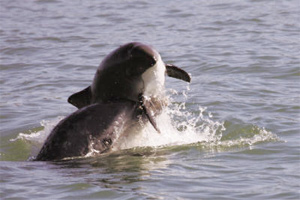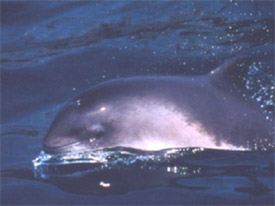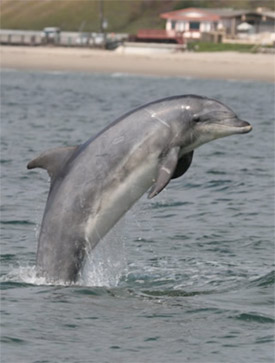
The mechanism responsible for several recent strandings of harbor porpoises (Phocoena phocoena) along the California coast was recently captured on film: death by bottlenose dolphin (Tursiops truncates). In September, marine biologists with Okeanis, a local non-profit organization, captured video of a group of male bottlenose dolphins harassing and killing a harbor porpoise in Monterey Bay. The video shows the dolphins corralling the porpoise off New Brighton Cove, ramming it with their beaks, scraping or raking it with their teeth, and finally drowning the porpoise by jumping on top of it. The dolphins then brought the carcass up to the Okeanis researchers and watched them bring it aboard before swimming away. The reason behind the attack is unclear, but this type of behavior has been observed in dolphins elsewhere. (Source: Wilson, A. Video shows dolphins attacking porpoise. The Monterey County Herald. November 6, 2009. p. A5). To see the video, click here.
In the United Kingdom (UK) a growing number of harbor porpoise strandings have been attributed to bottlenose dolphin attacks after autopsies revealed severe trauma coupled with tooth and rake marks that matched patterns from bottlenose dolphins.
In California last year there were 74 harbor porpoise strandings, many showing similar signs of trauma.

Killer whales or Orcas, another type of dolphin, have also been observed killing harbor porpoises off the San Juan Islands. UK scientists have suggested that competition for declining fish populations could trigger the dolphin attacks; however, this is only conjecture. Bottlenose dolphins in California have not been known to attack seals and sea lions, which compete more directly than porpoises for food, so it may not be a significant factor.
Another hypothesis for the attacks stems from observations that bottlenose dolphins exhibit aggressive behavior in the practice of infanticide. There are documented cases of males dolphins killing calves in order to mate with the females, which are not receptive to mating while caring for their babies. Dolphin calves and harbor porpoises are approximately the same size, which may be a reason why they are targets for this male aggression. While several hypotheses are proposed to explain the attacks, there is insufficient evidence to draw any firm conclusions at this time.

Okeanis, the Santa Barbara Museum of Natural History, the Marine Mammal Center and Moss Landing Marine Mammal Center are collaborating to try to better understand this phenomenon. While this type of behavior may seem strange to people, it is not unique to Monterey Bay and not unheard of in the animal kingdom. It is a newly documented behavior for this area, which warrants further investigation into the causes of these incidents.
|